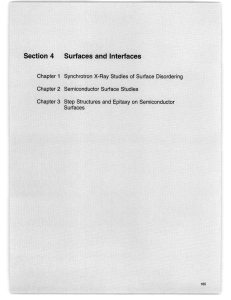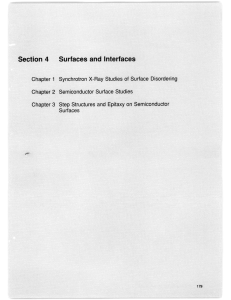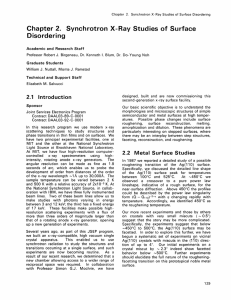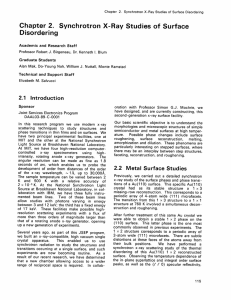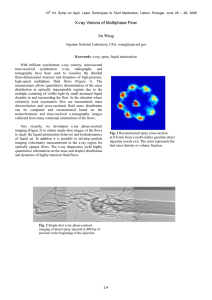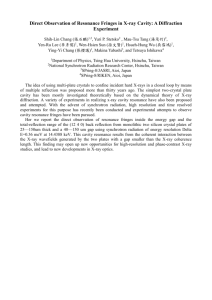Chapter 2. Synchrotron X-ray Studies ... 2.1 Introduction
advertisement
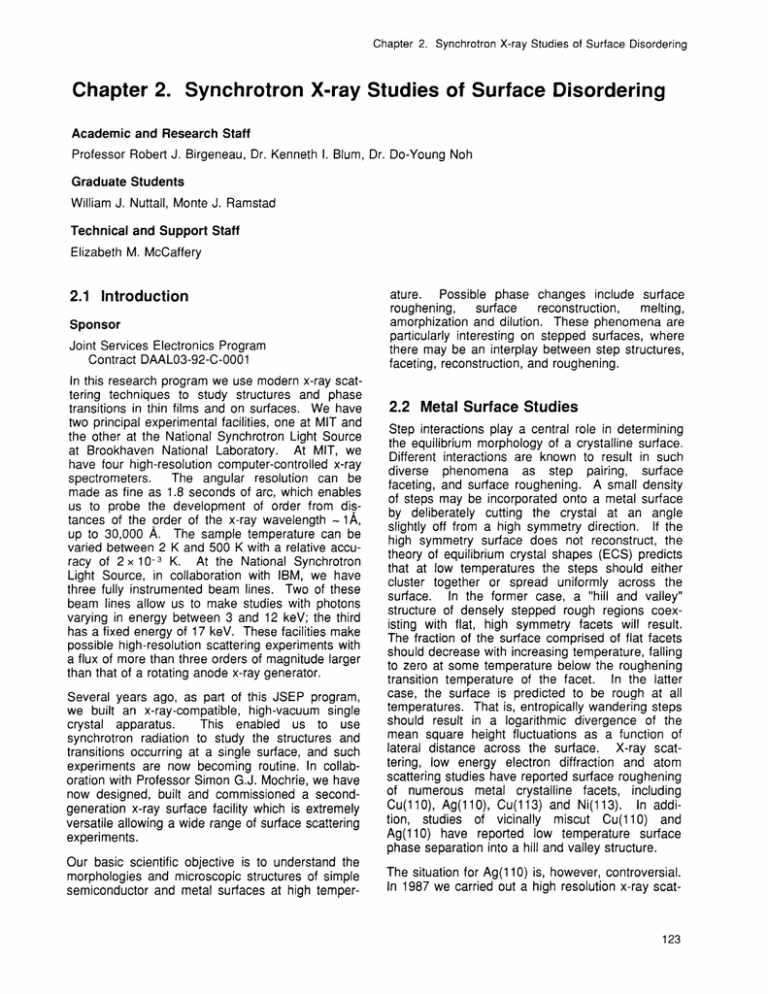
Chapter 2. Synchrotron X-ray Studies of Surface Disordering Chapter 2. Synchrotron X-ray Studies of Surface Disordering Academic and Research Staff Professor Robert J. Birgeneau, Dr. Kenneth I. Blum, Dr. Do-Young Noh Graduate Students William J. Nuttall, Monte J. Ramstad Technical and Support Staff Elizabeth M. McCaffery 2.1 Introduction Sponsor Joint Services Electronics Program Contract DAAL03-92-C-0001 In this research program we use modern x-ray scattering techniques to study structures and phase transitions in thin films and on surfaces. We have two principal experimental facilities, one at MIT and the other at the National Synchrotron Light Source at Brookhaven National Laboratory. At MIT, we have four high-resolution computer-controlled x-ray spectrometers. The angular resolution can be made as fine as 1.8 seconds of arc, which enables us to probe the development of order from distances of the order of the x-ray wavelength -1 A, up to 30,000 A. The sample temperature can be varied between 2 K and 500 K with a relative accuracy of 2 x 10- 3 K. At the National Synchrotron Light Source, in collaboration with IBM, we have three fully instrumented beam lines. Two of these beam lines allow us to make studies with photons varying in energy between 3 and 12 keV; the third has a fixed energy of 17 keV. These facilities make possible high-resolution scattering experiments with a flux of more than three orders of magnitude larger than that of a rotating anode x-ray generator. Several years ago, as part of this JSEP program, we built an x-ray-compatible, high-vacuum single crystal apparatus. This enabled us to use synchrotron radiation to study the structures and transitions occurring at a single surface, and such experiments are now becoming routine. In collaboration with Professor Simon G.J. Mochrie, we have now designed, built and commissioned a secondgeneration x-ray surface facility which is extremely versatile allowing a wide range of surface scattering experiments. Our basic scientific objective is to understand the morphologies and microscopic structures of simple semiconductor and metal surfaces at high temper- ature. Possible phase changes include surface roughening, surface reconstruction, melting, amorphization and dilution. These phenomena are particularly interesting on stepped surfaces, where there may be an interplay between step structures, faceting, reconstruction, and roughening. 2.2 Metal Surface Studies Step interactions play a central role in determining the equilibrium morphology of a crystalline surface. Different interactions are known to result in such diverse phenomena as step pairing, surface faceting, and surface roughening. A small density of steps may be incorporated onto a metal surface by deliberately cutting the crystal at an angle slightly off from a high symmetry direction. If the high symmetry surface does not reconstruct, the theory of equilibrium crystal shapes (ECS) predicts that at low temperatures the steps should either cluster together or spread uniformly across the surface. In the former case, a "hill and valley" structure of densely stepped rough regions coexisting with flat, high symmetry facets will result. The fraction of the surface comprised of flat facets should decrease with increasing temperature, falling to zero at some temperature below the roughening transition temperature of the facet. In the latter case, the surface is predicted to be rough at all temperatures. That is, entropically wandering steps should result in a logarithmic divergence of the mean square height fluctuations as a function of lateral distance across the surface. X-ray scattering, low energy electron diffraction and atom scattering studies have reported surface roughening of numerous metal crystalline facets, including Cu(110), Ag(110), Cu(113) and Ni(113). In addition, studies of vicinally miscut Cu(110) and Ag(110) have reported low temperature surface phase separation into a hill and valley structure. The situation for Ag(110) is, however, controversial. In 1987 we carried out a high resolution x-ray scat- 123 Chapter 2. Synchrotron X-ray Studies of Surface Disordering tering study of a vicinal Ag(110) surface using a crystal which had been inadvertently miscut by - 0.50; we interpreted the data on the basis of a roughening transition of the flat (110) facets at 725 K. More recently, Robinson and coworkers have re-addressed this problem using a Ag(110) crystal miscut by - 0.20. They assert that, in equilibrium, their 0.20 vicinal Ag(110) surface phase separates into flat (110) facets together with stepped regions for temperatures below 790 K and that a uniform step structure is only stable above that temperature. In order to resolve this controversy and to understand generally the behavior of stepped Ag(110) surfaces, we have carried out x-ray scattering and scanning tunneling microscopy (STM) studies of a Ag(1 10) sample miscut 10 from the (110) axis along the (110) direction. The STM measurements have been performed at IBM by R.M. Feenstra and G.A. Held. For a clean and well annealed surface, we find that at all temperatures above 300 K, the surface is comprised of a uniform density of single atomic height meandering steps. That is, we find no evidence for vicinal phase separation. However, as the surface is annealed to sufficiently high temperatures, we find that impurities are driven to the surface and that this, in turn, results in the formation of large, flat (110) terraces. The latter is the behavior reported by Robinson and coworkers although they interpreted their data assuming a clean surface. For the clean surface we observe of uniform, albeit diffraction characteristic meandering, steps at all temperatures between 300 K and 875 K. With increasing temperature, the step peaks lose intensity and undergo an evolution in lineshape consistent with a decrease in step-step correlations, most noticeably in the (001) direction. While our data above 670 K are consistent with a rough surface, the peak evolution is not consistent in detail with the simplest model of entropically repulsive steps. 2.3 Semiconductor Surface Studies As discussed above, vicinal surfaces, that is, surfaces of crystals cut close to a high symmetry direction, exhibit remarkably rich and diverse physical behavior. At equilibrium, such surfaces may exhibit roughening, faceting, and/or reconstruction transitions. Novel non-equilibrium phenomena also may occur. One of the most interesting and well-studied systems is vicinal Si(111). At temperatures immediately above the 1 x 1 to 7 x 7 reconstruction transition at 1100 K, this surface can be described by flat (111) terraces separated by uniformly spaced single Si(111) bilayer steps. In recent synchrotron x-ray experiments we demonstrated that the "uni- 124 RLE Progress Report Number 135 formly" stepped surface is in fact rough with logaBelow rithmically divergent height fluctuations. 1100 K the 1 x 1 --7 x 7 transition drives a faceting transition in which the steps phase-separate yielding flat, reconstructed (111) terraces and wellordered but higher-angle stepped regions. We have determined the temperature dependence of the surface roughness above 1100 K, a regime where significant numbers of atoms sublimate. Remarkably, the surface height fluctuations exhibit a logarithmic divergence up to 1275 K even under significant sublimation. This is best represented by a power-law line shape diffraction profile of the step lattice characterized by the exponent Tr. Representative power law diffraction profiles are shown in figure 1. At - 1275 K, the surface undergoes a sharp morphological transition to one characterized by large uniform (111) terraces plus highly disordered stepped regions. This faceting was apparently observed previously, although on a Si(111) surface with a very small miscut (8') compared with a 30 miscut on our Si( 111) sample. Our x-ray experiment reveals that the faceting is accompanied by a step disordering transition in which the step correlations change drastically. Above the disordering transition the height fluctuations of the surface diverge much faster than the Data on the thermal logarithmic divergence. stepped region diffraction peak position and width are shown in figure 2. We speculate that the "transition" is a non-equilibrium phenomenon driven by a combination of sublimation and electromigration. Our results are consistent with theoretical predictions for growing stepped surfaces. The discovery of this new transition on thoroughly studied and structurally perfect silicon surfaces should cast light on the general problems of surface morphology at high temperatures. 2.4 Model Surface Overlayers Much of the basic physics of surface systems, including both clean surfaces and surfaces with physisorbed or chemisorbed overlayers, is determined by general structural and symmetry considerations. For this reason, experiments on model systems such as rare gas overlayers on graphite can provide important insights with implications for all surface systems. An important illlustration of this is the chiral 3-states Potts model description of the melting of the 1 x 3 reconstruction of Si(113) as described by Simon G.J. Mochrie in this report. The theory for this semiconductor surface transition was ofnginall developed to describe the melting of the 3 x3 structure of monolayer krypton on graphite. Chapter 2. Synchrotron X-ray Studies of Surface Disordering Figure 1. Longitudinal scans of the primary step superlattice peak for a 30 miscut Si(111) crystal below 1270 K with background subtracted. The scans are plotted relative to the integer order peak position of the (111) facets. The solid curves are the results of fits to a power law singularity form for the step correlations. There is no change in the lineshape in this temperature range other than sharpening due to annealing. Recently, we have carried out a series of experiments on xenon overlayers physisorbed onto single crystal graphite. These experiments have focused on two issues: (1) the evolution of the structure as a function of temperature for one, two, three and six layers; and (2) the nature of the melting transition for coverages in the monolayer region. Results of both sets of experiments are still being analyzed. The essential features of the multilayer studies may be summarized as follows. Monolayer xenon exhibits a commensurate-incommensurate transition at about 65 K. Bilayer xenon exhibits more elaborate behavior. For temperatures above 60 K, the two layers have the same lattice constant with a value incommensurate with respect to the substrate. At 60 K the layer of xenon closest to the graphite locks into registry with the substrate while the second layer remains incommensurate. On the Figure 2. Longitudinal and transverse scans of the step superlattice peak across the disordering transition near 1275 K. The solid curves are the results of fits of the step peak to an anisotropic displaced Lorentzian. Note the drastic change in the width of the longitudinal scans. other hand, the three- and six-layer xenon systems remain uniform and incommensurate at all temperatures. Monolayer xenon on graphite has been viewed as a model system for studying melting in two dimensions. There is, however, disagreement in the interpretation of thermodynamic and scattering data on the order of the melting transition at various coverages. Specifically, scattering studies suggest a continuous melting process whereas themodynamic data have been interpreted on the basis of first order melting transition for coverages near but below one monolayer. We have studied the melting as a function of pressure and hence chemical potential at fixed temperatures of 121 K, 140 K, and 146 K. At the two higher temperatures, we find that the solid diffraction peak decreases progressively in intensity with decreasing pressure evolving continuously into the diffraction pattern characteristic of a strongly correlated fluid with well-developed orientational order. This necessitates that the melting transition is at least nearly continuous. We are currently carrying out a detailed line-shape analysis of the diffraction profiles to obtain quantitative information on the melting transition. 125 Professor Sylvia T. Ceyer 126 RLE Progress Report Number 135
